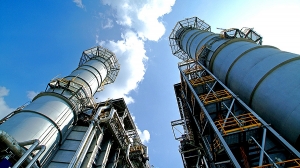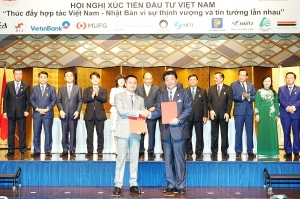Vietnam towards cleaner energy with LNG power blend-policy outlook
 |
| Vaibhav Saxena and Tran Thi Ha Phuong, lawyers at Vietnam International Law Firm |
Electricity demand in Vietnam is increasing by about 10 per cent per year, putting remarkable pressure on the power industry to ensure a stable supply for economic development and ensuring demand and supply balance. At present, Vietnam’s energy mix is reliant mainly on traditional sources such as hydroelectricity and thermal power which are on the verge of saturation and conventional sources like coal are being discarded by the world due to their hazardous impact on the environment. Though LNG is not a zero-carbon-footprint club member, it is better than most other thermal power sources.
Planning
In March 2016, the Revised Power Development Plan (RPDP7) was approved for the 2016-2030 period (it is under further revision and PDP8 is expected in 2020). Under RPDP7, gas thermal power, which includes normal gas thermal power, besides LNG power, is targeted to achieve 44 billion kilowatt-hours in 2020, 76 billion kWh in 2025, and 96 billion kWh in 2030. The total capacity of gas-fired power plants is targeted to reach 9 million kW in 2020, 15 million kW in 2025, and 19 million kW in 2030, respectively.
Besides, RPDP 7 highlights the aim of developing the system of LNG warehouses and import ports in the provinces of Son My and Binh Thuan for the purpose of providing further gas facilities with proper terminals for different power centres such as Phu My and Nhon Trach which happen to be the ice breakers in LNG power generation.
Forms of investment
As a matter of laws and practice in Vietnam, large power projects, excluding renewable power projects, are normally developed under (i) an independent power producer (IPP); or (ii) a public-private partnership (PPP) investment project, commonly in the form of a build-operate-transfer (BOT) one. An IPP project is wholly funded by the private party without using any capital from the state budget, while a PPP project is based on the co-operation between a state party and a private party. Compared to an IPP project, the BOT mechanism is preferred for its distinct characteristics providing for security through various guarantees and incentives from the government. In other words, the government is traditionally witnessed to grant a Government Guarantee and Undertaking (GGU) to the investors and the project company of BOT power projects, mainly including (i) material supply; (ii) off-take of products; (iii) all payment obligations and all financial commitments; and (iv) right to conversion of payment by Vietnam Electricity (EVN) from VND to USD and foreign remittance of USD.
Investment Incentives
LNG Power plant project invested in the form of PPP with total investment capital of more than VND2.3 trillion ($100 million) is qualified for investment incentives. The investor shall enjoy different investment incentives, which can be briefly illustrated as follows:
- Corporate Income Tax: 10 per cent for 15 years, extendable to up to 15 years with the prime minister's approval. Besides, the investor shall enjoy exemption for the first four years and 50 per cent reduction in the subsequent nine years;
- Import Duty: LNG Project is exempted from import duty on goods imported to create fixed assets for the project;
- Land Rental: LNG is entitled to land use fee/rental incentives at par with a project in the preferential investment sectors. Subject to the location of the project, it may also be exempted from land use fee/land rental for a period ranging from three to 15 years or for the whole term.
In case the LNG Power plant project is invested in the form of IPP, such IPP shall only enjoy the above investment incentives if it has a total investment capital of more than VND5 trillion ($217.39 million), which requires approval from the PM.
Power Purchase Agreement (PPA)
LNG power project does not have a specific model PPA like solar or wind power projects and stands quite open for negotiation to have a PPA that can catch up with international standards. However, in accordance with Article 1(2a) of Circular 56, the template PPA incorporated in the said circular is applicable to LNG power projects. Circular 56 does not apply to IPP projects in the form of BOT. The template PPA under Circular 56 includes the following notable points:
- Off-take: Under the template PPA, EVN or its authorised subsidiary that takes over all rights and obligations of EVN in accordance with the laws acting as the power purchaser has the responsibility to off-take the entire electricity output generated to the grid by the relevant LNG power project. The concern may be raised by investors as to EVN-authorised subsidiary which serves as the buyer, that is whether EVN shall be liable for any breach or failure of the authorised subsidiary in performing the PPA signed with the project company.
- Contract price: A calculating formula is mainly based on four factors, that is yearly-fixed cost, monthly-fixed for operation, and maintenance in month, monthly-variable cost, and main fuel transportation cost. Adopting pricing formulas that allow LNG price fluctuations to automatically feed through into electricity tariffs on a regular basis without any need for regulatory intervention is an effective way to mitigate financial risk for the investor in case of an increase in LNG price.
- Grid-connection and metering system: The power seller remains responsible for building and maintaining the interconnection facilities under the template PPA. However, the template PPA has not addressed the scenarios where the power plant is prevented from generating electricity due to unavailability or other risks associated with the grid.
- Events affecting the implementation of the PPA: The template PPA provides only three events (not including other events) affecting the implementation of the PPA comprising (i) events relating to dissolution and bankruptcy of both parties, (ii) material breach of the PPA not remedied within 90 days from date of notice and (iii) operation suspended by the decision of a competent state agency.
- Step-in rights: Step-in rights are critical to the lenders’ and allow them to preserve essential contracts entered into by the project company in the event of default by such project company. For PPP projects, as a matter of established practise, lenders’ rights are well negotiated. However, for IPP projects, the step-in rights can be negotiated as well.
- Change in law: Vietnam has ensured a stable investment atmosphere for many years, but the laws and regulations keep on changing from time to time based on the development planning and needs of the country, which poses a risk for the investors who are investing on a long-term basis like in LNG power. Nevertheless, the template PPA does not specifically address risks of change in law (including change in the interpretation and application of the law). Although, the Law on Investment 2014 provides protection to the investor and the project company in the event of a change in laws or policies, during the PPA negotiation the parties may consider basing their contention on the said law to have a better bankable PPA.
LNG importation
Gas has an important role in Vietnam’s future energy landscape, with LNG importation now being a key feature of Vietnam’s energy policy. As per the master plan on development of Vietnam's gas industry to 2025, with outlook up to 2035, the development of the gas industry is based on the principle of cost-effective and reasonable use of domestic natural resources; on developing the import of LNG in parallel with exploiting new domestic gas sources to supplement diminishing [depleted] gas sources in order to maintain unhindered capacity to supply gas to consumers.
An importer of LNG must satisfy all conditions under Article 6 of Decree 87, including (i) Being a company incorporated in accordance with the laws of Vietnam; (ii) Owning or having a wharf lease agreement with a lease term of five years minimum, and these wharves must be included within the Vietnamese port network/system; (iii) Owning gas tanks or having a gas tank lease agreement which meets all safety regulations; (iv) Satisfying conditions for fire prevention and fighting; and (v) Having LPG bottles or a contract for leasing LPG bottles satisfying all the conditions for circulation on the market by business entities exporting and importing LPG and trading bottled LPG. If business entities import LNG via pipelines, in addition to satisfaction of the conditions prescribed in (i), (ii) and (iii) above, they must have gas transporting pipelines and gas supply stations which satisfy all conditions for safety, and fire prevention and fighting. The importer shall be issued with a certificate for business entity importing LNG upon fulfilment of all required conditions.
Conclusion
Besides the advantages such as huge power consumption, increasingly supportive government rhetoric for promoting greater gas use, cheap labour cost, and so on, foreign investors diving into the LNG power sector in Vietnam may face lots of challenges including (i) high LNG investment cost; (ii) the developing regulatory framework for LNG-to-power in Vietnam may bring in uncertainties; (iii) dealing with state-owned enterprises is an arduous task sometimes due to their way of functioning and limited exposure for the investor to do due diligence; and (iv) Vietnam does not have enough domestic gas resources and it has to import fuel to run LNG power plants, that will add up to costs.
The regulatory framework in Vietnam's LNG sector needs to be refreshed to support better investment opportunities for foreign investors. Furthermore, Vietnam needs to maintain a balance between economic goals and energy security so that Vietnam does not face power shortages in the future while at the same time as a matter of economic independence for the country it is advisable for a sovereign nation to build ample reserves of LNG in Vietnam and avoid basing its power generation model that depends majorly on imported fuel. Better policies can provide comfort to the investors to establish LNG storage facilities in Vietnam and the country will benefit by having ample fuel on its ground to satisfy its energy needs in the future.
 | Gulf redoubles efforts to develop power plants in Vietnam Thai firm Gulf Energy Development Plc. plans to develop power plants in Vietnam and Laos to strengthen its presence in Indochina. |
 | Foreign interest in Vietnam’s LNG sector remains high Foreign investors are diving into developing liquefied natural gas (LNG) and gas-fired power projects in Vietnam, in part due to country’s growing demand for electricity. |
 | Petrolimex and JXTG Nippon Oil & Energy co-operate on LNG project Vietnam National Petroleum Group (Petrolimex) has entered into a co-operation with Japan's JXTG Nippon Oil & Energy in a bid to build facilities and collaborate ... |
What the stars mean:
★ Poor ★ ★ Promising ★★★ Good ★★★★ Very good ★★★★★ Exceptional
 Tag:
Tag:
Related Contents
Latest News
More News
- Schaeffler reports strong early output from Dong Nai solar project (December 12, 2025 | 15:16)
- Forestry conference highlights biodiversity and sustainability goals (December 09, 2025 | 13:35)
- Home Credit honoured among top 10 sustainable companies in trade and services (December 09, 2025 | 12:18)
- SCG and seven member companies honoured in Top 100 Sustainable Businesses 2025 (December 08, 2025 | 09:00)
- Nestlé Vietnam pioneers sustainable development and promotes business connections (December 06, 2025 | 12:09)
- CSI 2025 highlights rise of Vietnam’s green champions (December 06, 2025 | 09:00)
- Acecook Vietnam named among top 100 sustainable businesses (December 06, 2025 | 08:00)
- Vietnam’s forest carbon credits draw global interest (December 05, 2025 | 17:41)
- Coro Energy to launch BESS Pilot in Vietnam (December 04, 2025 | 15:12)
- Vietnam strengthens energy storage pathway (December 04, 2025 | 15:05)


























 Mobile Version
Mobile Version